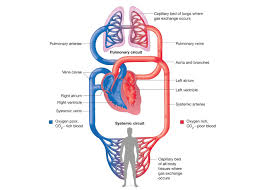Human Blood and its Circulation
 Composition of blood — Blood is made up of fluid called plasma (60%) and a greater number of blood cells called corpuscles (40%). Plasma is 90% water with proteins and inorganic salts. Organic substances such as glucose, amino acids, fats, urea, hormones and enzymes, occur in plasma. Corpuscles are of two kinds, red and white. Red corpuscles are produced in the spleen. They form the majority of blood corpuscles. They contain the protein pigment haemoglobin which gives the red colour. It also has iron. White corpuscles are much less in number. These are of various kinds, some of which destroy disease germs which may enter the blood. Haemoglobin is a protein pigment in red blood cells. It combines readily with oxygen in lungs to form a loose compound called oxyhaemoglobin which is transported to tissues where it breaks up into haemoglobin and oxygen. The oxygen is used up by tissues for oxidation and the resultant carbon dioxide is carried away by the blood.
Composition of blood — Blood is made up of fluid called plasma (60%) and a greater number of blood cells called corpuscles (40%). Plasma is 90% water with proteins and inorganic salts. Organic substances such as glucose, amino acids, fats, urea, hormones and enzymes, occur in plasma. Corpuscles are of two kinds, red and white. Red corpuscles are produced in the spleen. They form the majority of blood corpuscles. They contain the protein pigment haemoglobin which gives the red colour. It also has iron. White corpuscles are much less in number. These are of various kinds, some of which destroy disease germs which may enter the blood. Haemoglobin is a protein pigment in red blood cells. It combines readily with oxygen in lungs to form a loose compound called oxyhaemoglobin which is transported to tissues where it breaks up into haemoglobin and oxygen. The oxygen is used up by tissues for oxidation and the resultant carbon dioxide is carried away by the blood.
Blood group — is the grouping of people whose blood may be mixed without clumping of blood corpuscles. A, B, AB and O are the four main blood groups. When blood of any two different groups is mixed, agglutination or clotting of blood corpuscles occurs and so only blood of the same group is used in blood transfusion.
Heart — It is a strong muscular organ situated in the chest between the right and left lungs and enclosed in a bag called the pericardium. It lies behind the breast bone and the ribs slightly to the left. It has two auricles on the upper half and two ventricles on the lower half, separated from each other by partitions. These parts have valves between them.
Blood circulation — Auricles and ventricles of the heart contract and expand alternately. The right auricle receives impure blood from a large vein and the left auricle receives pure blood from the lungs. Both kinds of blood are forced into two ventricles by the contraction of two auricles. Now the two ventricles contract, valves close the opening between auricles and ventricles (systole) and hence no blood can go back into the auricles. Thus, the pure blood from the left ventricle goes into a large aorta and the impure blood from the right ventricle goes into the pulmonary artery. The aorta takes blood to various parts of the body. The pulmonary artery takes impure blood to the lungs. When ventricles relax (diastole) the auricles are again filled with blood and the same process is repeated. The contractions of ventricles are called heart beats.
Veins — They have valves and contain blood flowing to the heart. The backward flow of blood (away from the heart) by the pulsation of heart is checked by these valves.
*******






